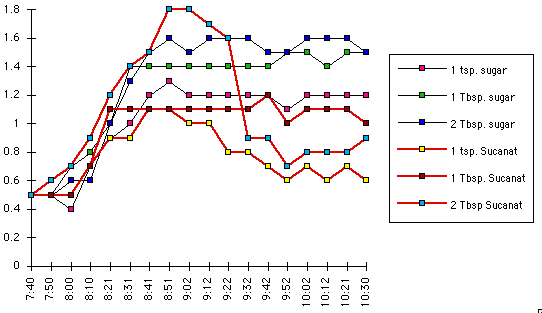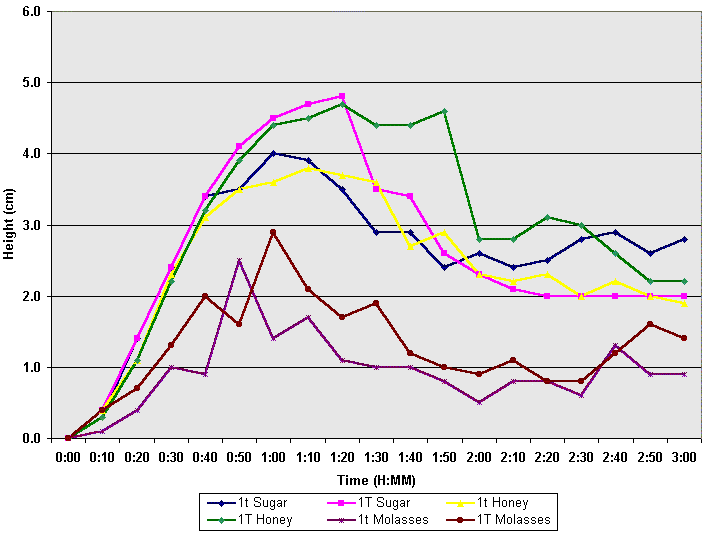| Sean Crist's Homepage: Personal | Home > Personal > Pages > Sucanat | Contact |
Differences between Sugar and Sucanat in Promoting Yeast Growth
Originally posted around 1998.
My boyfriend Dennis and I used to regularly make bread in a kitchen bread machine. We noticed that when Dennis mixed up the ingredients, the bread turned out fine; but when I mixed up the ingredients, the bread turned out very flat and heavy like a brick, as if it hadn't risen.
We finally figured out what we were doing differently: Dennis was using ordinary refined table sugar, but I was substituting Sucanat (TM), a brand of dried, unrefined sugar cane juice. While I'm all in favor of avoiding refined sugar as much as possible, it looks as though Sucanat is not suitable as a substitute for sugar in bread machines.
To test this idea, I did the following experiment. I set up six identical drinking glasses and poured 1/2 c. of lukewarm water into each. I used water from the same pitcher to ensure uniform temperature (unfortunately, I didn't have a suitable thermometer for measuring the water temperature, but at least the temperature was the same for all six glasses).
Into each glass, I measured 1 1/2 tsp. bread yeast. In the first three glasses, I added varying amounts of sugar (1 tsp, 1 Tbsp, 2 Tbsp); in the second three, I added corresponding amounts of Sucanat (again, 1 tsp, 1 Tbsp, 2 Tbsp). I stirred each glass with a separate spoon and set all six side by side on our dining room table, ensuring equal temperature, air, and lighting conditions for all six glasses.
I took measurements of the height of the bubble development in each glass approximately every 10 minutes. Because of a slight irregularity in the shape of the glasses, the initial heights of the 1/2 c. water were not identical; these discrepancies are normalized in the chart below. The respective initial heights were 4.6cm, 4.6cm, 5cm, 4.5cm, 4.7cm, and 4.7cm; the chart below normalizes the initial height for each glass to 0.5cm. In a better controlled experiment, I would want to use beakers or burettes of uniform dimensions.
Further, I doubt that my measurements are accurate within the one millimeter scale of the chart. For example, the height of the bubbles was not always uniform around the entire edge; the measurement would depend on which side of the glass I placed the ruler. Thus, some of the small fluctuations in the chart are probably due to measurment limitations. I think the measurements are pretty accurate within 2mm, however.
The results were as follows:

The generalization over the final heights is as follows. The three glasses containing sugar had a higher final height than any of the glasses containing Sucanat. Secondly, there is a tendency for a greater amount of sweetener to correspond to a greater final height, but the 2 Tbsp. Sucanat glass is problematic.
The visual quality of the bubbles differed greatly between sugar and Sucanat. The sugar bubbles were tiny and uniform, formed a dense foam, and held up well over time. The Sucanat bubbles were much larger, were irregular in size, and tended to rupture. The most dramatic case of this was the rupture of bubbles in the 2 Tbsp. Sucanat glass between 9:22 and 9:32, accounting for the plummeting height in that time interval on the chart; a similar but less dramatic pattern also occurred for the 1 tsp. Sucanat glass. The sugar glasses, by contrast, reached a peak and then maintained an essentially flat level afterwards.
I'm all in favor of Sucanat in most cases, and have had excellent results using it in other baked recipes, such as peanut butter cookies. In the case of bread, however, it appears that Sucanat is not suitable. Based on the experiment above, my guess is that there's some trace substance in sugar cane juice which interferes with the desired growth pattern for bread yeast; presumably, this substance is refined out of sugar but not out of Sucanat. I regret not having set up three more glasses to test the use of honey under the same circumstances.
Thanks to Dennis Dillahunt in helping to make the initial observation about the results of our bread and in helping with the experiment. Sucanat is a registered trademark of Sucanat North America Corporation.
2 Feb 2001: Update
CatMoran [External Link] did a similar experiment using different sweeteners. Here are the results:

| Last updated 31 May 2010 |